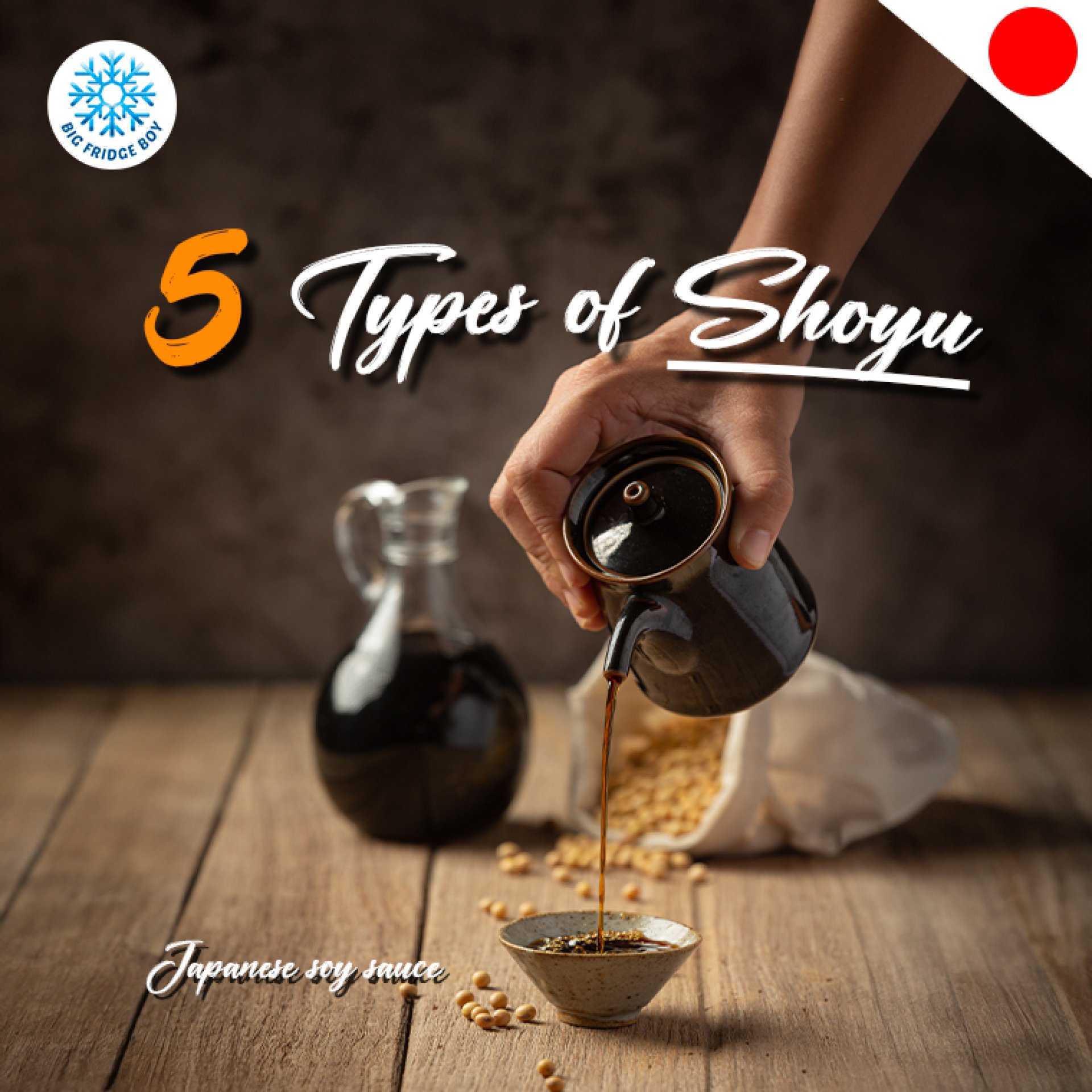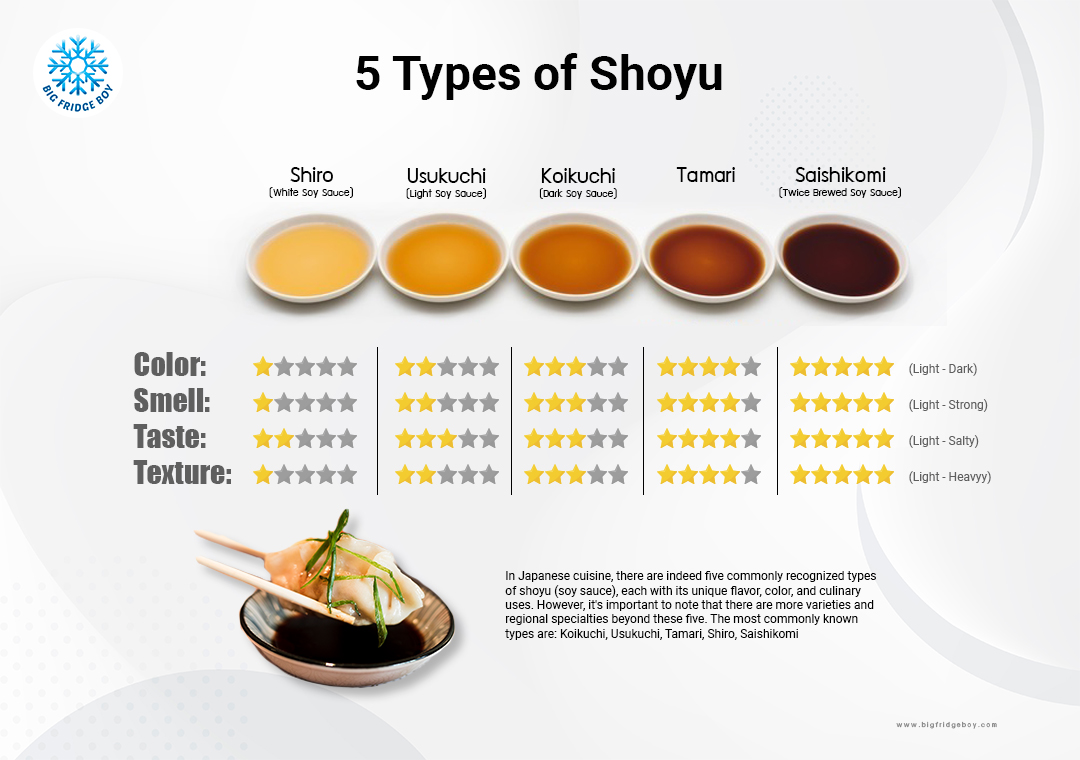5 Types of Shoyu (Japanese Soy Sauce)

Shoyu, or soy sauce, is unique due to its complex flavor profile that balances salty, sweet, and umami tastes, a result of the traditional fermentation process of soybeans and wheat. This process, essential to its distinctive flavor and aroma, varies across regions, giving rise to different types of shoyu with specific characteristics. Its deep cultural and historical roots in Asian cuisine, along with its versatility in cooking as a seasoning, marinade, or dipping sauce, further add to its uniqueness. The nutritional aspect of shoyu, containing amino acids and antioxidants, also contributes to its distinctiveness, making it a versatile and irreplaceable ingredient in global cuisines.
Historical Background
The Evolution of Shoyu in Japan.
The history of shoyu (soy sauce) dates back to ancient China, where its predecessor, a fermented fish sauce called "jiang," was developed over 2,500 years ago. This sauce evolved into a soy-based condiment as it spread across Asia. By the 7th century, this early form of soy sauce reached Japan, likely through Buddhist monks. The Japanese refined and adapted the recipe, leading to what we now recognize as shoyu.
In Japan, shoyu's production became more sophisticated, particularly during the Edo period (1603-1868), where different varieties began to emerge. The addition of wheat to the fermentation process was a significant Japanese innovation, distinguishing their soy sauce from the Chinese version, which used only soybeans.
Shoyu's popularity spread worldwide as Japanese cuisine gained international acclaim. Today, it is an essential ingredient in many Asian dishes and a popular condiment globally, appreciated for its unique flavor and versatility in cooking.
The Main Ingredients of Shoyu
The main ingredients used to make shoyu (Japanese soy sauce) are:
- Soybeans: The primary ingredient, soybeans are the foundation of shoyu, providing the essential proteins and flavors that define the sauce.
- Wheat: Wheat is typically used in equal parts with soybeans, especially in traditional shoyu. It contributes to the sauce's unique flavor and aroma.
- Salt: Salt is crucial for flavor and acts as a preservative. It also plays a vital role in the fermentation process.
- Water: Water is used to create the brine in which the soybeans and wheat are fermented. The quality of water can significantly affect the final taste of the shoyu.
- Koji Mold (Aspergillus oryzae or Aspergillus sojae): This mold is used to ferment the soybeans and wheat, breaking down their proteins and starches to create the complex flavors and aromas characteristic of shoyu.
These ingredients are combined and undergo a fermentation process, which can vary in duration and technique depending on the type of shoyu being produced. The meticulous balance and quality of these ingredients, along with the fermentation process, are what give shoyu its distinctive taste.
The production and fermentation process of soy sauce
The production and fermentation process of soy sauce is complex and intricate, involving several steps:
- Ingredient Preparation:
The first step in making soy sauce starts with selecting the main ingredients: soybeans, wheat, salt, and water. The soybeans are soaked in water and then steamed, while the wheat is roasted or crushed. - Koji Making:
Koji is a crucial ingredient in the soy sauce fermentation process. It is made by cultivating the Aspergillus oryzae or Aspergillus sojae fungus on the prepared soybeans or wheat. Koji helps convert the starch and proteins in the ingredients into sugars and amino acids. - Fermentation:
The koji mixture is combined with salt water to create a mash called "moromi". Fermenting soy sauce can take several months to several years, depending on the desired recipe and flavor. During this period, complex chemical changes occur, resulting in the flavor, aroma, and color of the soy sauce. - Maturation:
After fermentation, additional maturation occurs, enhancing the complexity of the flavor and aroma. Sometimes additional ingredients are added at this stage. - Filtering:
Once maturation is complete, the soy sauce is filtered to separate the solids from the liquid. The remaining liquid is the usable soy sauce. - Pasteurization:
The soy sauce is pasteurized to extend its shelf life and ensure consistent flavor. This process also helps to eliminate unwanted microorganisms. - Packaging and Distribution:
After pasteurization, the soy sauce is packaged in containers for sale.
The process of producing and fermenting soy sauce is a blend of science and art. Each recipe and brand of soy sauce has variations in technique and fermentation time, resulting in a soy sauce with unique flavors and characteristics.
The comparison between organic and pasteurized soy sauce
- Production Method and Ingredients:
- Organic Soy Sauce: Made from 100% organic ingredients, meaning the soybeans, wheat, salt, and water used in production are grown or processed sustainably without chemicals or pesticides.
- Pasteurized Soy Sauce: Pasteurization involves heating the soy sauce to kill bacteria and extend its shelf life. This type of soy sauce may not necessarily be made from organic ingredients.
- Organic Soy Sauce: Made from 100% organic ingredients, meaning the soybeans, wheat, salt, and water used in production are grown or processed sustainably without chemicals or pesticides.
- Flavor and Characteristics:
- Organic Soy Sauce: Often has a more complex and natural flavor as it does not contain chemical additives or preservatives. Consumers who prefer products free from chemical modifications tend to choose this type.
- Pasteurized Soy Sauce: Pasteurization may slightly alter the flavor and aroma of the soy sauce but helps ensure consistency and safety for consumption.
- Organic Soy Sauce: Often has a more complex and natural flavor as it does not contain chemical additives or preservatives. Consumers who prefer products free from chemical modifications tend to choose this type.
- Shelf Life:
- Organic Soy Sauce: May have a shorter shelf life compared to pasteurized soy sauce due to the absence of preservatives or chemical additives.
- Pasteurized Soy Sauce: Has a longer shelf life because the pasteurization process kills bacteria and extends usability.
- Organic Soy Sauce: May have a shorter shelf life compared to pasteurized soy sauce due to the absence of preservatives or chemical additives.
- Health Impact:
- Organic Soy Sauce: Typically has fewer or no residual chemicals, as it is produced from sustainably grown ingredients without agricultural chemicals or pesticides. It is often preferred by consumers concerned about the health impacts of chemicals.
- Pasteurized Soy Sauce: While pasteurization makes the soy sauce safer in terms of bacterial contamination, it may contain preservatives or additives to extend its shelf life, which can impact nutritional quality.
- Organic Soy Sauce: Typically has fewer or no residual chemicals, as it is produced from sustainably grown ingredients without agricultural chemicals or pesticides. It is often preferred by consumers concerned about the health impacts of chemicals.
- Certification and Standards:
- Organic Soy Sauce: Must pass stringent production and inspection standards to be certified as organic, which includes scrutiny of the entire production process and the origin of ingredients.
- Pasteurized Soy Sauce: For soy sauce that is pasteurized, organic certification is not necessary, but the pasteurization process and other ingredients must meet food safety standards set by health authorities.
- Organic Soy Sauce: Must pass stringent production and inspection standards to be certified as organic, which includes scrutiny of the entire production process and the origin of ingredients.
In conclusion, the choice between organic and pasteurized soy sauce depends on personal preferences and the importance given to sustainable farming, natural taste, safety, shelf life, as well as health concerns and production standards.
5 Types of Shoyu (Soy Sauce)
In Japanese cuisine, there are indeed five commonly recognized types of shoyu (soy sauce), each with its unique flavor, color, and culinary uses. However, it's important to note that there are more varieties and regional specialties beyond these five. The most commonly known types are

Koikuchi (Dark Soy Sauce)
The standard and most prevalent type in Japan, used in a variety of dishes for its balanced flavor.
- Production: Made from roughly equal parts soybeans and wheat, which contributes to its balanced flavor.
- Flavor: Balanced, with a rich umami taste and a slightly sweet undertone.
- Color: Dark brown, which can impact the color of the dish.
- Ideal For: Your everyday dishes. It's a superstar in marinades for grilled meats, a staple for seasoning stir-fries, and a must-have for sushi and sashimi.
- Food Pairings: Try it with grilled chicken, beef, or vegetable stir-fries. It also works wonders in noodle dishes like ramen or soba.
Usukuchi (Light Soy Sauce)
Less salt and lighter in color than koikuchi, it's used in dishes where color preservation is important.
- Production: Fermented for a shorter period than koikuchi.
- Flavor: Less salt than koikuchi, with a milder soy taste.
- Color: Lighter, making it suitable for dishes where maintaining the original color is important.
- Ideal For: Dishes where you want to preserve the original color but add depth. Think clear soups, broths, and light sauces.
- Food Pairings: Perfect for seasoning delicate dishes like seafood broths, steamed fish, or even in the preparation of pickles.
Tamari
Thicker, with a stronger flavor and a higher soybean content. It contains little to no wheat, making it suitable for gluten-free diets.
- Production: Made mainly from soybeans, with little or no wheat, which makes it thicker and richer.
- Flavor: Richer and less salty, with a strong umami profile.
- Color: Dark, similar to koikuchi but often thicker.
- Ideal For: When you need a gluten-free option with a rich, umami punch. Excellent as a dipping sauce.
- Food Pairings: Sushi, sashimi, and dumplings. Also great in hearty stews or as a dip for tempura.
Shiro (White Soy Sauce)
Lighter and sweeter, used in dishes that require a subtle soy sauce flavor.
- Production: Higher wheat content than soybeans, contributing to its lighter flavor and color.
- Flavor: Milder and sweeter compared to other types.
- Color: Very pale, preserving the natural color of ingredients.
- Ideal For: Adding a hint of sweetness without overpowering. Best in light, refined dishes.
- Food Pairings: Enhance the flavors of delicate dishes like chawanmushi, dressings for salads, or light seafood dishes.
Saishikomi (Twice Brewed Soy Sauce)
Re-fermented for a deeper flavor, used in special dishes.
- Production: Brewed twice, where soy sauce replaces the brine in the second brewing, resulting in a richer sauce.
- Flavor: More intense and complex, with a deeper umami taste.
- Color: Very dark, similar to koikuchi but more pronounced.
- Ideal For: Giving dishes a deep, rich flavor. Use it to bring complexity to sauces and marinades.
- Food Pairings: Perfect for bold dishes like braised meats, flavorful soups, or to add an extra layer of taste to teriyaki sauce.
The comparison between Japanese soy sauce and soy sauce from other countries:
- Ingredients and Formula:
- Japanese Soy Sauce: Typically made from soybeans, wheat, salt, and water. In some types like Koikuchi, it contains equal parts of soybeans and wheat.
- Soy Sauce from Other Countries: May have different formulas, such as Chinese soy sauce, which often relies more on soybeans and may not include wheat, resulting in a stronger and saltier flavor.
- Japanese Soy Sauce: Typically made from soybeans, wheat, salt, and water. In some types like Koikuchi, it contains equal parts of soybeans and wheat.
- Flavor and Intensity:
- Japanese Soy Sauce: Characterized by its complex and balanced flavor, combining salty, sweet, and umami tastes. Japanese soy sauce comes in various types, each with its unique flavor profile.
- Soy Sauce from Other Countries: The flavor and intensity can vary. For example, Chinese soy sauce generally has a more robust and saltier taste than its Japanese counterpart.
- Japanese Soy Sauce: Characterized by its complex and balanced flavor, combining salty, sweet, and umami tastes. Japanese soy sauce comes in various types, each with its unique flavor profile.
- Production and Fermentation Process:
- Japanese Soy Sauce: Involves a complex and prolonged fermentation process, taking several months to years, to develop its delicate flavors.
- Soy Sauce from Other Countries: The production methods may differ, with some countries employing shorter fermentation processes or techniques different from those used in Japan.
- Japanese Soy Sauce: Involves a complex and prolonged fermentation process, taking several months to years, to develop its delicate flavors.
- Culinary Uses:
- Japanese Soy Sauce: A staple condiment in Japanese cuisine, used differently depending on the type of soy sauce.
- Soy Sauce from Other Countries: Usage may vary according to culinary traditions and culture in each country.
- Japanese Soy Sauce: A staple condiment in Japanese cuisine, used differently depending on the type of soy sauce.
- Variety of Types:
- Japanese Soy Sauce: Offers a wide range of types, such as Koikuchi, Usukuchi, Tamari, Shiro, and Saishikomi.
- Soy Sauce from Other Countries: The classification of soy sauce may not be as diverse as in Japan, often focusing more on the intensity of flavor.
- Japanese Soy Sauce: Offers a wide range of types, such as Koikuchi, Usukuchi, Tamari, Shiro, and Saishikomi.
In summary, Japanese soy sauce is distinct and refined in terms of formula, taste, and production process compared to soy sauces from other countries, which may vary in ingredients and production methods.
Interesting facts and lesser-known details about soy sauce that you might find intriguing
- Ancient Origins: Soy sauce has ancient origins, tracing back to a condiment called "jiang" in China over 2,500 years ago. This precursor to modern soy sauce was likely a fermented paste made from grains and meat or fish.
- Variation Across Cultures: While soy sauce is integral to Asian cuisine, its type and usage vary significantly across different Asian cultures. For example, Japanese soy sauce (Shoyu) tends to be milder and sweeter compared to the stronger and saltier Chinese versions.
- Health Benefits: Soy sauce is rich in amino acids, which come from the proteins in soybeans broken down during fermentation. It's also a good source of antioxidants and has been studied for its potential health benefits, including aiding digestion and providing essential minerals.
- Fermentation Process: The fermentation process for traditional soy sauce can take several months to several years. This long fermentation contributes to the development of soy sauce's unique umami flavor.
- Not Just for Savory Dishes: While commonly used in savory dishes, soy sauce can be used in sweet applications too. In some culinary practices, it's added to desserts for a complex flavor profile.
- Non-Soy Soy Sauces: There are soy sauce alternatives made without soy for those with allergies. These are often made from fermented grains like rice and barley.
- Color Variations: Soy sauce comes in different colors, from light to dark. The color can affect not just the appearance of a dish but also its taste. Light soy sauce is often used for its flavor, while dark soy sauce is typically used for color.
- Cultural Significance: In Japan, soy sauce is not just a condiment but also holds cultural significance. It's used in various ceremonies and traditional practices.
- Variety of Flavors: Beyond the basic salty flavor, soy sauce can have various flavor notes like sweet, fruity, smoky, and umami, depending on the ingredients and fermentation process.
- A Craftsmanship Product: High-quality artisanal soy sauces are still made using traditional methods, and some are aged like fine wine, developing deeper flavors over time.
These facts highlight the rich history, cultural significance, and versatility of soy sauce in culinary traditions around the world.




